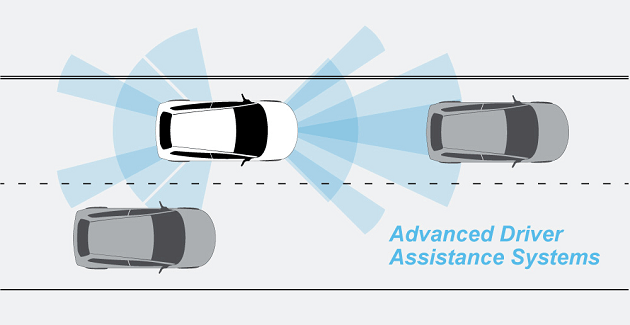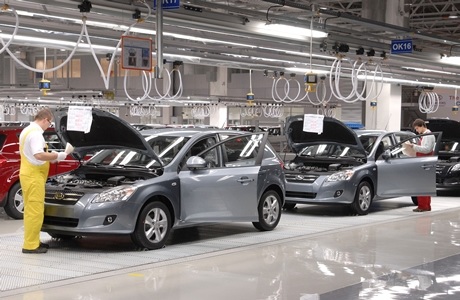The infrastructure of Indian roads might still be problem ridden and not be above the mark, but there is no stop to Smarter Automotive pulling up in the Indian parking lot. India is now the playing ground for every major automotive technologies, and major component companies are coming up with expertise and makeovers with smarter communications, greener technologies and wider safety measures which was out of picture until recently. Here are few major Electronics Companies, sharing their inputs on the Indian Automation Industry scenario and its future trajectory.
- What are the primary requirements of the Indian automotive technology market today?
Infineon: Regulations on safety and emission, along with the market demand for car features offer numerous opportunities for automotive electronics. Increasing focus on green technologies – electric 2W’s and PV’s, safety features – airbags, anti-lock braking, in-vehicle electronics – lighting, passive keyless entry, body control modules and comfort solutions amidst trends in automotive light-weighting and engine downsizing is expected to be seen.
National Instruments: With the Electrification of vehicles companies like Tesla having achieved huge success in the Electric Vehicle Market, people are looking towards more and more electric vehicles. Similarly there is a huge focus on Advanced Driver Assistance System or ADAS. ADAS has a very wide scope and can range from cameras and sensors like LIDARs and ultrasonic proximity sensors providing the driver parking assistance to a lot more. A lot of companies right now are focusing on having Automotive Radars working in the high frequency bands to detect obstacles like an airplane does.
Texas Instruments: Electric Vehicles (EV) / Hybrid Electric Vehicles (HEV) are of major interest because of restrictions with fuel usage and increasing pollution. There would be good requirement of charging stations for these vehicles so as to encourage EV/HEV. With Li-Ion emerging into EV/HEV, complete battery management system with high level safety is primarily required to increase the reliability. Technologies like ultrasonic based sensors, camera based detection or RADAR based parking assist systems are likely to be installed in almost all four wheelers.
Electromagnetic Interference (EMI) compliance is an important topic for many major automotive manufacturers trying to build the newest systems for cars. Apart from these, improving user experience with systems like USB charging for 2 Wheelers, IOT cluster, LED head lamps and sensors like – Rain light sensor, soot sensor, AMT sensor, EGRT sensor, Radar etc. will be required in near future.
Analog Devices: Automotive manufacturers are focusing on passenger safety, infotainment, optimum fuel consumption and ease of drive in the entry level vehicles. This has led to entry level passenger vehicles having air bags, ABS, tyre pressure sensing, keyless entry, proximity sensing for drivers, start/stop feature and infotainment. These have almost become like a ‘must have’ primary requirements in the passenger vehicles. The 2-wheeler segments also have the start/stop feature given that there is an emphasis on optimum fuel consumption in this segment.
- What are the most sought-after innovations in the field of automotive done recently?
Infineon: With higher expectations from customers on reliability and quality, mechanical and electro-mechanical components are replaced by semi-conductor solutions. Some good examples are the replacement of starter relays, conventional bulbs with LED lights, motors with brushless motors, and battery with Lithium-Ion technology.
National Instruments: There are many recent innovations that have happened in the Automotive Industry recently.
- Vehicle Electrification(EVs/HEVs): With the fossil fuels becoming scarce and expensive as well as stringent emission norms, more and more OEMs would be looking to venture into the field of vehicle electrification and launching models in their electric vehicle categories sooner to win the race.
- ADAS(Advanced Driver Assistance Systems)
- Radars: Short range and long range automotive Radars capable of detecting within a vicinity of few tens of meters and that too with a good spatial resolution between them.
- Cameras: A lot of work going on towards having multiple cameras mounted on the car and having a GPU (graphical processing unit) stitch together images from these individual cameras to give the complete 360o view around the car.
- Sensor Fusion: Vendors these days are trying to move towards sensor fusion which involves merging multiple sensors together into a unified system with a controller to process these signals and communicate this information over a vehicular bus to other controllers.
- Autonomous Driving: This involves communications between vehicles (Vehicle to Vehicle Communication- V2V), Vehicle to Infrastructure (V2I) communication and Vehicle to Everything (V2X) Communication. There are multiple competing wireless standards like IEEE 802.11p and Cellular V2X or LTE V2X and each one has its own benefits.
- Infotainment Systems: The infotainment systems inside cars provides a lot of functionality in terms of navigation, digital audio and video broadcasts from the satellites, making and receiving calls, connectivity via Bluetooth, etc. There is a lot of investment that both the OEMs in India as well as the Tier 1 suppliers are doing.
- Advanced cars also have features like Remote Keyless Entry(RKE), Passive Entry Passive Start(PEPS) and Tyre Pressure Monitoring Systems(TPMS)
- Automotive Ethernet:
With streaming of huge amount of data coming from cameras and other sensors, efforts have been in place to develop new faster communication standards based on the existing Ethernet standards.
Texas Instruments: Millimeter wave (mmWave) is a special class of radar technology that uses short wavelength electromagnetic waves. Radar systems transmit electromagnetic waves of varying frequency that travels to the objects along path of the vehicle and then reflect back. By capturing the reflected signal, a radar system can determine distance and velocity of the objects.
Adaptive lighting is another innovative approach to implement features like directive lighting, anti-glare feature etc.

Figure. Various levels automation in automotive systems and associated technologies
Analog Devices: Automakers and tech companies have been designing innovative car features from holographic dashboards to rotating chairs to high fidelity infotainment system, while making the cars safe. Other innovations include driverless cars, automated manual transmission, vehicle to vehicle communication, anti-collision technology, smart cars to electric vehicles.
- Where do you find your company in the automotive application industry?
Infineon: Infineon is a leading player and pioneer in automotive electronics. Infineon is helping to create more sustainable mobility choices by lowering emissions and fuel consumption. They develop semiconductor solutions for a wide range of powertrain applications such as transmission, multi-port and direct injections, alternator regulator, and pumps. In (H) EV, they offer solutions in the main and auxiliary inverters, HV/LV DC-DC and AC-DC (battery charger).
Infineon is working on solutions for airbag system, brake vehicle stability control (VSC), electric brake booster, EPS, active suspension control system, radar system, TPMS and in-cabin sensing applications.
They also offer solutions for HVAC control module, front light, LED rear light, interior and ambient light control, roof control, seat control, smart window lift and power distribution for start-stop systems.
Infineon’s development strategy focuses on the integration of functionality in semiconductor solutions with an excellent price-performance ratio.
National Instruments: National Instruments is investing heavily towards providing leading technologies to the Automotive Industry in terms of Test & Measurement. National Instruments works with multiple different industries like Automotive, Aerospace & Defence, Semiconductor, etc. and provide software defined instruments for Test & Measurement. Some of the applications that NI does in terms of Test & Measurement in the Automotive Industry are as follows:
- Hardware-In-The-Loop Testing or Embedded Software Validation, which allows Validation engineers to test the critical embedded codes going on the Electronic Control Units going inside the vehicles.
- Testing Infotainment systems by generating radio & navigation standards from a Vector RF Signal Generator and then analyzing the audio measurements on its Dynamic Signal Analyzers.
- Test various subsystems for ADAS like Radars, Cameras, Sensors, etc. by simulating test scenarios around the subsystems using various Simulation Environments available in the market.
- End-Of-Line Testing of Automotive Components can be for a brake booster, shock absorber, or for functional hardware validation of a Power Distribution module. They also provide Control & Measurement Solutions for Test Cells like Engine Testbeds and dynamometer testing as well as customized solutions for endurance or life cycle tests.
 Texas Instruments: TI delivers innovative products in Advanced Driver Assistance Systems (ADAS), Infotainment, Hybrid/Electric vehicles, Powertrain, Body Electronics and Lighting enabling automotive OEMs and Tier 1s to deliver the next-generation of safer, highly connected and greener automobiles to consumers.
Texas Instruments: TI delivers innovative products in Advanced Driver Assistance Systems (ADAS), Infotainment, Hybrid/Electric vehicles, Powertrain, Body Electronics and Lighting enabling automotive OEMs and Tier 1s to deliver the next-generation of safer, highly connected and greener automobiles to consumers.
TI’s advanced driver assistance system (ADAS) solutions are driving the development of safety-enhancing applications that are enabling a safer driving environment for drivers, passengers and pedestrians.
TI makes it easier to design infotainment system, body electronics and lighting systems for any type of vehicle. Whether designing a cluster, head unit, HMI display or other infotainment system, TI has the analog and embedded processing solutions to design end to end system.
TI delivers all the building blocks, from analog to embedded processing solutions that enables the electrification of vehicles. TI enables improved performance and safety functionality throughout the hybrid/electric and powertrain systems for the next generation of low emission vehicles, while also driving down system cost to make it accessible for any vehicle to have enhanced performance and innovation.
Analog Devices: Both automotive manufacturers and Tier ones turn to Analog Devices, to create safer, greener, and more comfortable automobiles. The technologies from Analog Devices are targeted for ADAS & Autonomous driving, Infotainment, MEMS safety, powertrain and Chassis. The acquisition of Linear Technologies uniquely positions ADI as a leading solution provider in the Battery management system space. Other acquisitions like the one for LIDAR technology, positions Analog Devices as one of the leaders in providing ADAS and autonomous driving solutions for cars.
- Please share with us about the range of products offered by your company and their specific technical application in the automotive sector.
Infineon: Infineon’s Radar System IC (RASIC) series consists of a group of highly integrated functions for the 76–77 GHz range for automotive radar. Infineon’s AURIX 32-bit multicore ADAS derivative offers a dedicated feature set for radar applications which, in many cases, renders additional DSP, external SRAM and external ADC ICs obsolete. Infineon aslo offers system power supply, CAN and FleRay transceivers, transmitter and receiver ICs, wave form generator IC and low noise linear post regulators to complete the radar system.
National Instruments: NI provides Hardware-In-The-Loop Test Solutions leveraging the PXI platform. The tester is composed of a PXI chassis having an Embedded PC which is the PXI controller capable of simulating simulation models of the system being controller deterministically and the signals are sent or received using the required modules out of the wide range of 1500+ modules available for 70+ vendors. The hardware capability is completely open as the customer can customize the I/O modules being used according to their I/O signaling requirements as well as they can use modules from a 3rd party vendor who complies with the open PXI standard.
One of the latest addition to our RF instrument portfolio has been of industry’s highest bandwidth Vector Signal Transceiver (PXI 5840) which provides 1 GHz of instantaneous bandwidth and is suitable for testing wide band automotive radars and well as simulating multiple parallel radio stations or RF standards while testing an infotainment system.
Texas Instruments: TI’s 77 GHz single-chip digital signal processor (DSP) integrated solution is there to address issues like fatal accidents due to human error. TI’s mmWave sensors can work under any environmental condition and provide highly accurate measurements in a small form factor with low-power consumption. TI has solved challenges in designing individual components of TX, RX, clocking etc by designed complementary metal-oxide semiconductor (CMOS)-based mmWave radar devices that integrate TXRF and RX-RF analog components such as clocking, and digital components such as the ADC, MCU and hardware accelerator.
Ultrasonic front end device PGA460-Q1 realizes park assist and blind spot detection in automobiles. Features like Time Varying Gain (TVG), Multiple Presets, and One wire protocol enable precise measurement of obstacles.
For Li-Ion battery management in EV/HEV, bq76Pl455A-Q1 accurately monitors and protects up to 16 Li-ion cells in series. Its robust differential communications allow the stacking of up to 16 ICs to form large battery packs without using expensive isolators and CAN controllers/transceivers. The part significantly reduces system cost by monitoring 16 channels (vs. 12 of most of the competition) and protecting each of them with overvoltage and undervoltage comparators (vs. a separate protector for the competition). In 48V systems a single chip can replace up to four competitor ICs.
Driver notifications can be found in steering wheels or seats and alert drivers when other automobiles are in their blind spots, or when they cross over lanes unintentionally. The DRV2605L-Q1 was created to drive ERMs and includes an integrated waveform library for different types of effects. This gives designers the flexibility to notify drivers with effects such as ramping buzzes, pulsing alerts and buzzes of different lengths.
Analog Devices: Analog Devices’ converter, amplifier, Drive360 RADAR, MEMS, sensor, sensor interface, digital isolator, processor, and RF technologies are a key element of innovative, cost-effective, high-performance system designs. ADI components and application-specific ICs can be found in systems for rollover and stability control, airbag and crash sensing, RADAR and vision driver assistance, HEV/EV power management, 12V battery management, fuel injection, transmission control, head units, audio amplifiers, and many other emerging applications.
Analog Devices Connect is an IoT development and deployment platform. It allows customers to build IoT Cloud based automotive applications with little coding and cloud experience, saving significant development time and cost enabling faster time to market.
- How promising is the Indian market for intelligent driving and electric cars, given the Government of India’s agenda on making the Indian roads free of fuel vehicles by 2030?
Infineon: The plan to go all electric by 2030 is certainly ambitious. It would require significant investment from the public and private sectors, not just in the infrastructure but also in product development. It is the first step in the right direction to reduce dependency on fossil fuels as India modernizes. Infineon is committed to support green technologies and have the solutions for efficient systems.
Texas Instruments: The future of EVs looks quite promising. However, lack of charging infrastructure and initial high cost are becoming major hurdles to increase sale of EVs in India. OEMs are trying to find ways for making EVs an affordable and convenient option for the common man. Charging stations need to be installed to encourage and attract users to buy electric cars. Many start-ups have came up in India who are working on different subsystems like Battery Management System (BMS), EV chargers, Brushless DC (BLDC) drives etc. With these there should be good eco-system in future for this segment.
Analog Devices: The Government of India has formed a consortium consisting of all leading automotive manufacturers to help develop a supplier base for critical hybrid and EV components. The government wants to see 6 million electric and hybrid vehicles on the roads by 2020 under the National Electric Mobility Mission Plan (NEMMP) 2020 and Faster Adoption and Manufacturing of Hybrid and Electric Vehicles (FAME). The government has been offering subsidies on electric and hybrid vehicles for bikes and cars. Any shift to EVs will help reduce pollutants and fuel imports.
Contributors:













